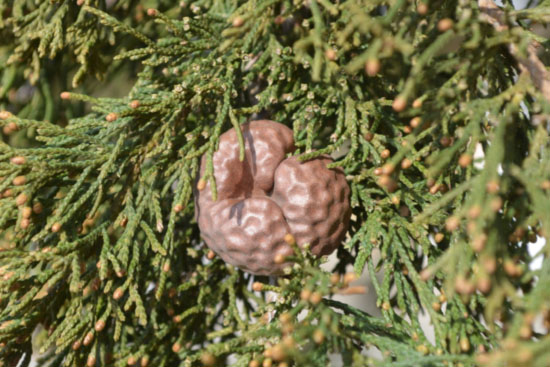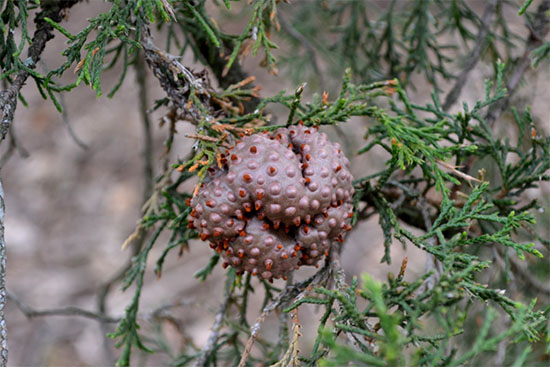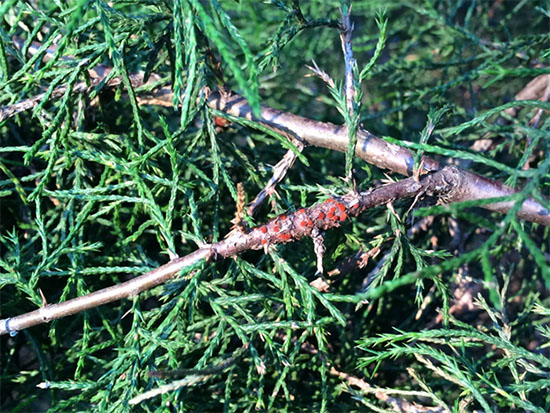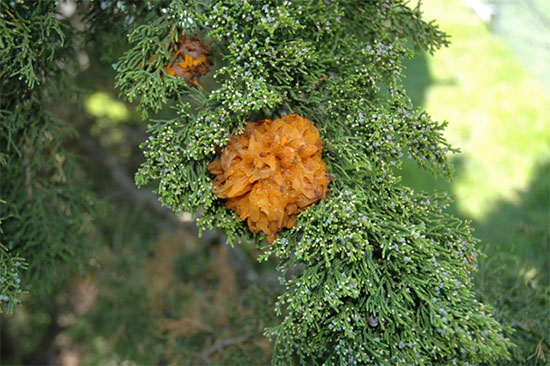Issue 1, April 20, 2015
Gymnosporangium Rusts on Eastern Red Cedar
Telial growth has started to emerge from overwintering Gymnosporangium rust galls. Early stages of the telial emergence are pictured below. Three Gymnosporangium rusts commonly affect trees in Illinois landscapes: Cedar-apple rust, Hawthorn rust, and Quince rust. These pathogens require two hosts to complete their life cycles. The most damaging stage occurs on deciduous hosts within the rose family, Rosacea. Apples, crabapples, hawthorns and quince are some of the more commonly affected deciduous species. Infections to deciduous hosts occur in the spring as the new leaves are developing, but the infections won't become evident until later in the season. Eastern red cedar and other Juniperus spp. serve as evergreen alternate hosts for these pathogens. Infections to evergreen hosts are not as damaging, but are an important stage in each pathogen's life cycle. These rust pathogens overwinter on Eastern red cedars as hard and pitted galls or swollen branches. Galls are light brown to reddish or chocolate brown and range from 1/8 inch to 2 inches in diameter).

Over-wintering Cedar-apple rust gall on Eastern red cedar. Photo taken Feb. 2014

Rust gall on Eastern red cedar with telial growth starting to emerge. Photo taken April, 2014.

Early emergence of the telial stage of cedar quince rust on Eastern red cedar. Photo taken April 2015.
As spring temperatures increase and moisture fluctuates, the galls form distinct orange, gelatinous spore masses (Image 4). Spores produced within these masses are then dispersed by air and infect nearby susceptible deciduous hosts.

Gelatinized telia on Eastern red cedar. Photo credit: Nancy Pataky.
The most common control strategies for Gymnosporangium rusts in the landscape focus on protecting the deciduous hosts. These recommendations start with utilizing resistant or immune species and varieties. Where feasible, infections to broad-leaved hosts can be reduced by removing unwanted host trees within a ½ mile radius. Galls can also effectively be pruned out or hand-picked from small junipers during the fall and winter months. Fungicide sprays are effective at protecting susceptible trees from infection. Many of the fungicides used to protect deciduous hosts are also labeled for use on Juniperus spp. If fungicides are deemed necessary to protect an evergreen host, they should be applied at two-week intervals during July and August or as directed by specific product label recommendations. (Travis Cleveland)
Author:
Travis Cleveland